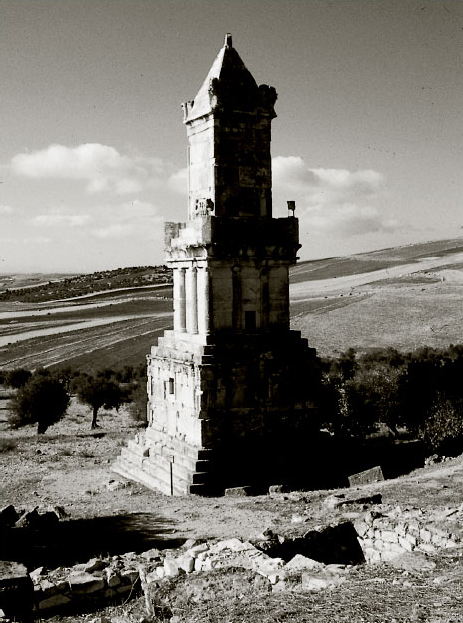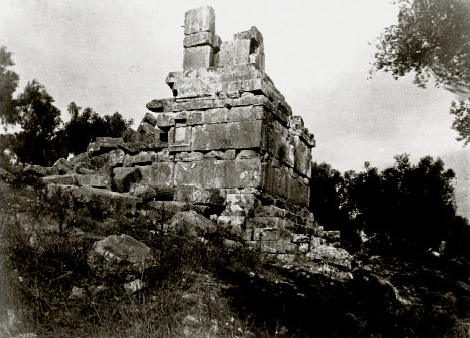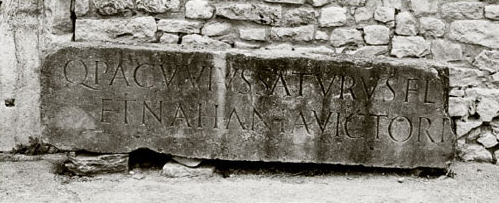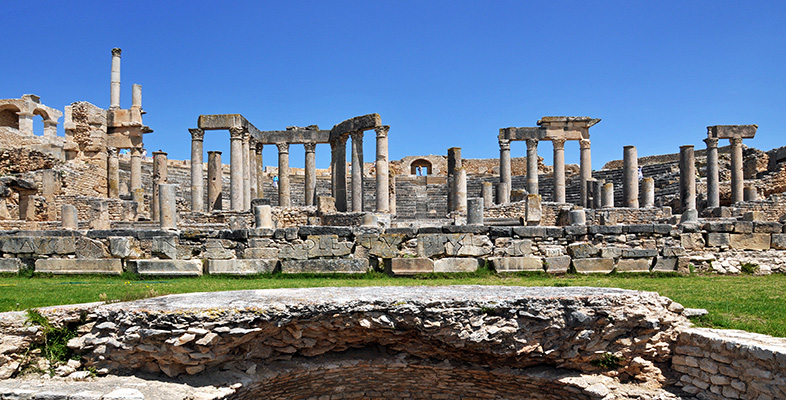2 Investigating Roman and indigenous cultural elements in the archaeology of Africa
2.1 Looking in detail at Thugga
In this section you will be looking in more detail at the city of Thugga and working with the video and further evidence. This study of a city will then broaden out to consider other forms of material and visual evidence from different parts of Africa; you will also watch more video sequences. This section focuses upon one aspect of Romano-African culture: the interplay between Roman culture and indigenous African culture. This theme is one of a range of ‘binary oppositions’ which may be set up as a vehicle for investigating this part of the Roman empire. Other approaches could take the opposition of ‘soldier’ and ‘civilian’, or ‘emperor’ and ‘subject’, or ‘pastoralist’ and ‘agriculturalist’, or ‘desert’ and ‘sown’ areas, using these as avenues of approach to the study of Africa. Here you will be investigating a meeting of cultures: African and Roman. African culture has left none of its own literature, and its achievements have not been as highly valued as other cultures, such as the Greek culture, in the subsequent centuries. Because of this your study will start with material remains and monuments.
The first task is to try to tease out what can be seen as African characteristics in Roman Africa. To do this you will now be working in more detail on the city of Thugga. Thugga lies near the eastern boundaries of Numidia, which was an independent kingdom until 46 BC when it was annexed and became part of the Roman provinces of Africa and Numidia. The kingdom had urban centres such as Thugga, Bulla Regia and Simitthus, and was open to influences from the wider Mediterranean world. There was also a developed culture which had been exposed to Hellenistic influences. A good example of this is the Punic royal funerary monument at Thugga, which combines Punic and Hellenistic features (see Figures 1 and 2). When Numidia became a part of the Roman empire, we might assume that Roman cultural influence would have become more pronounced and that perhaps a Roman identity might begin to emerge. But how might this be identified, and what kinds of things should we look for? Is it possible to see a distinct Roman culture and identity which might be compared and contrasted with a Numidian, or more generally an African, culture and identity?


Activity 1
Using your knowledge of parts of the Roman world, and what you have seen in the ‘Exploring Thugga’ video, in the following list of features mark those which you think can be described as Roman in inspiration and which African or at least non-Roman. Also write a few words giving reasons for your choice. In some cases you may come to the opinion that some elements are both Roman and African; if so mark both boxes. You may like to watch ‘Exploring Thugga’ again to help you answer the questions, pausing the video at suitable points.
Exploring Thugga (part 1, 8 minutes)
Transcript: Exploring Thugga - Part One
Exploring Thugga (part 2, 8 minutes)
Transcript: Exploring Thugga - Part Two
Exploring Thugga (part 3, 8 minutes)
Transcript: Exploring Thugga - Part Three
| Feature | Roman? | African? | Reason |
|---|---|---|---|
| City walls | |||
| Street plan | |||
| Temple of Mercury | |||
| Temple of Augustan Piety | |||
| Capitol | |||
| Forum | |||
| Theatre | |||
| Political organisation | |||
| Arch of Alexander Severus | |||
| Temple of Caelestis | |||
| Temple of Saturn | |||
| Saturn the god | |||
| Circus | |||
| Baths | |||
| Construction techniques | |||
| People | |||
| Language |
Discussion
To answer the questions thoroughly would require detailed definitions of what was African and what was Roman, but even with such definitions the questions would not be easy to answer definitively and there is some subjectivity involved in the identifications. My answers (below) may differ slightly from yours. If they do, have a look at the reasons you and I have given and see if they explain why our opinions differ.
| Feature | Roman? | African? | Reason |
|---|---|---|---|
| City walls | These don't surround the whole Roman city and they pre-date most of it, so they are African, even if their construction is not very different to Roman walls. | ||
| Street plan | The street plan is not like a regular Roman city grid as, for example, in Aosta or parts of Pompeii. | ||
| Temple of Mercury | The god is Roman but the building doesn't look much like a typical Roman temple. | ||
| Temple of Augustan Piety | The temple is to a Roman imperial cult, even if the building doesn't look like a typical Roman temple. | ||
| Capitol | It is typical of Roman cities, e.g. Pompeii or Ostia, and mimics the temple of Jupiter on the Capitoline hill in Rome, even if it has a different relationship to the forum. | ||
| Forum | It is the typical centre of a Roman city, an open square with columns around it. | ||
| Theatre | The theatre is Roman in style, similar to those at Pompeii, Ostia and elsewhere. | ||
| Political organisation | The city seems to be divided into a pagus and a tivitas: these are both Roman terms (and so it is a Roman element) but it is not typical of a Roman city where the ordo of decurions was the governing body (and so it may be African). | ||
| Arch of Alexander Severus | The arch is a typical Roman monument to commemorate a triumph or other honour. | ||
| Temple of Caelestis | The goddess is not originally Roman and the whole building doesn't look much like a typical Roman temple enclosure; nevertheless the actual temple has a podium and columns much like a Roman temple. | ||
| Temple of Saturn | The form of the temple is not like a typical Roman temple so perhaps it is African, even though there was a Roman Saturn. | ||
| Saturn the god | He (and his name) is originally Roman, but he took over the attributes of the pre-Roman god Baal in Africa, so he can be called African. | ||
| Circus | This is Roman because it repeats the form of the Circus Maximus race-track in Rome and other chariot race-tracks elsewhere. | ||
| Baths | The baths are similar to bath buildings in Rome and elsewhere. | ||
| Construction techniques | Most of the walls are not built in typical Roman styles of masonry. | ||
| People | They have both Roman and non-Roman names. | ||
| Language | Latin seems to be the language used in inscriptions, but we don't know what was spoken in everyday conversations. |
The point of this activity is to make you focus upon what can be conceived of as Roman and to think about whether or not some of the things you have met so far in Africa are familiar because you have already encountered similar things in Rome or elsewhere in the empire. Some of the cases above are fairly clear cut. Something like a capitol is obviously typical of Roman cities. Its precise form may vary (indeed, at Thugga the temple is set side-on rather than end-on to the forum), but the configuration of a high temple with steps up the front and classical columns supporting a pediment with a cella behind dominating a forum fits the typical Roman model, as at Ostia or Pompeii. And we can get this far even before reading the dedication to the Capitoline Triad in the inscription above the door. Similar means can be used to suggest that the forum, theatre, circus, baths, and arch display features that we can recognise as distinctively Roman.
Other features, such as the temples of Saturn or Mercury, are harder to define as Roman: they may well use the same kinds of architecture but the ground plan is different, being like a rectangular courtyard or peristyle with three chambers set across a short end (see Plate 2). This is unlike the typical Roman temple: a building in an enclosure on a high podium with steps up the front and columns and a pediment on the facade. This style of temple has only ever been found in Africa, Mauretania and in the previously Punic Sardinia, and it does seem to be typical of African temples.
Please click to view Plate 2: Plan of the temple of Saturn, Thugga [Tip: hold Ctrl and click a link to open it in a new tab. (Hide tip)] . (Adapted from Poinssot, C. (1983) Les Ruines de Dougga, Tunis, Ministere des Affaires Culturelles, Institut National d'Archelogie et d'Arts) (PDF, 1 page, 0.4 MB).
We can see that the construction techniques are different; they employ a style known as opus Africanum (literally ‘African work’) that is characteristic of North Africa with origins that pre-date the Roman conquest. With this construction technique the wall is built incorporating vertical blocks of squared stones (orthostats), and the spaces between are filled with smaller blocks. Buildings you have seen elsewhere are built using different masonry techniques: brick-faced concrete (common in Ostia), small diamonds (common in Pompeii), small blocks of stone or larger squared blocks, for example.
We can also observe that the political organisation and some of the names of the people are different to those you may have encountered (see Figure 3). We can begin to suspect that these differences may be related to something we might be able to identify as an African cultural identity and cultural expression, which we might contrast with a Roman identity and culture.

If, then, we can perceive different influences that we may call African and Roman (we must remember these terms are a shorthand for complex cultures that are not monolithic or clearly defined), we may also consider what may have happened when these two ‘cultures’ met in Africa following the political conquest of the region.
